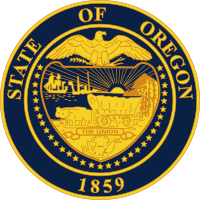Siletz
| Total population | |
|---|---|
| Fewer than 4,804 (2011)[1] | |
| Regions with significant populations | |
|
| |
| Languages | |
| English, formerly Dee Ni[2] and Tillamook[3] | |
| Related ethnic groups | |
| Tolowa and Salish peoples |
The Siletz are a Native American tribe from Oregon and an Indigenous people of the Northwest Plateau. In 1856 following the Rogue River Wars in southern Oregon, their people were among more than 20 Native American groups, speaking 10 distinct languages, who were forced by the United States to the Coast Indian Reservation, later known as the Siletz Reservation.
Over generations the Siletz people have intermarried with others at the reservation. Today their descendants are enrolled in the federally recognized Confederated Tribes of Siletz Indians of Oregon.
Although most descendants have Coastal Salish ancestry, the only native language still spoken on the reservation is Siletz Dee-ni, which linguists have found to be an Athabaskan language, related to the Tolowa language spoken by another of the original tribes. In cooperation with the National Geographic Society and the Living Tongues Institute for Endangered Languages, the tribe produced a "talking dictionary" of Siletz Dee-ni in 2007 to aid in preservation and teaching.[4]
History
Traditionally, the Siletz were believed to be a Salishan-speaking group; they inhabited an area along the central coast of Oregon near the Siletz River until the middle of the 19th century. The tribe was considered the southernmost group of the larger Coast Salish culture,[3] which was centered near the Strait of Georgia and Puget Sound in what are now British Columbia, Canada, and Washington, United States.
The Siletz were closely related in language and culture to the Tillamook tribe to their north along the Oregon Coast. During or after the Rogue River Wars of 1855–1856, which extended to areas of northern California, members of the tribe were moved by the United States government to the Coast Indian Reservation, later called the Siletz Reservation.
The Tillamook and peoples of more than 20 other small tribes, including the Tolowa people of northern California, were also removed to the reservation.[3] It is located along the Siletz River in the Central Oregon Coast Range, 15 miles northeast of Newport, which is on the coast in Lincoln County.
Language
Initially researchers believed that both the Siletz and Tillamook languages were Salishan languages. Tillamook was declared extinct when its last native speaker died in 1970.[3]
What is now known as the Siletz Dee-ni language was restricted historically to speakers in "a small area on the central Oregon coast."[2][4] Linguists have concluded that Siletz is not related to Tillamook at all, but is a form of Tolowa, an Athabaskan language rather than a Salishan language.[4] The Tolowa people were one of the 20 Native American groups whose descendants comprise the Confederated Tribes of Siletz.
In the 21st century, Siletz Dee-ni was the only native language still spoken on the reservation. Realizing that their language was endangered, the Consolidated Siletz tribe have taken actions to preserve and teach it. Also called Tolowa Dee-ni, the language has been studied by several groups (see books about the language below). Members of the tribe have worked with a variety of linguists to document the language. As they say, their work is "a comprehensive attempt to include the similarities and the differences of the known dialects of the Southwest Oregon / Northwestern California Athabaskan Language."[5]
The Siletz have also taken part in an international effort by the National Geographic Society, the Living Tongues Institute for Endangered Languages,[4] and linguists such as K. David Harrison of Swarthmore College to save languages that are threatened with extinction. Alfred "Bud" Lane, among the last fluent native speakers of Siletz on the reservation, has recorded 14,000 words of the Siletz Dee-ni language. Lane and other Siletz had decided they wanted to work to preserve and revive the language.[2]
Lane's work was used to help produce a Siletz talking dictionary, one of eight dictionaries produced for endangered languages in this project, as reported at the annual meeting in 2012 of the American Association for the Advancement of Science (AAAS). The bi-lingual dictionary, in English and Siletz Dee-ni, with illustrations, will be used to teach the dialect to tribal members in the Siletz Valley. Such digital tools and social media can help small groups communicate.[2] Professor Harrison said, "... a positive effect of globalisation is that you can have a language that is spoken by only five or 50 people in one remote location, and now through digital technology that language can achieve a global voice and a global audience."[2]
References
- ↑ "Enrollment", Confederated Tribes of Siletz Indians website, 8 Aug 2011 (retrieved 1 Sept 2011)
- 1 2 3 4 5 Jonathan Amos (18 February 2012). "BBC News - Digital tools 'to save languages'". Retrieved 2012-06-03.
- 1 2 3 4 "Siletz", Four Directions Institute. (retrieved 1 Sept 2011)
- 1 2 3 4 Anderson, Gregory D.S. and K. David Harrison. (2007). "Siletz Talking Dictionary". Living Tongues Institute for Endangered Languages. Retrieved 2012-06-03.
- ↑ "Guide to using the Siletz Dictionary" by Amy Smolek, in Anderson, Gregory D.S. and K. David Harrison. (2007) Siletz Talking Dictionary, Living Tongues Institute for Endangered Languages; accessed 25 November 2016
Further reading
- Tolowa Language Dictionary, 1st and 2nd Editions, by Loren Bommelyn
- Tolowa Dee-ni Language, by Loren Bommelyn, 1999.
- Tolowa Dee-ni Language: Vocabulary One, by Loren Bommelyn, 2000.
- Tututni/Sixes/Yuu-ke Dee-ne (Athabaskan) Language- Ida Bensell, by Victor Golla (also incorporated works with Ida by Elizabeth Jacobs).
External links
- Confederated Tribes of Siletz Indians, official site
- Siletz Language Project
- "Coast Salish tribes", University of Oregon
- "A Brief Interpretive History of the Rogue River War and the Coast, Alsea, and Siletz Reservations to 1894", California State University San Marcos
